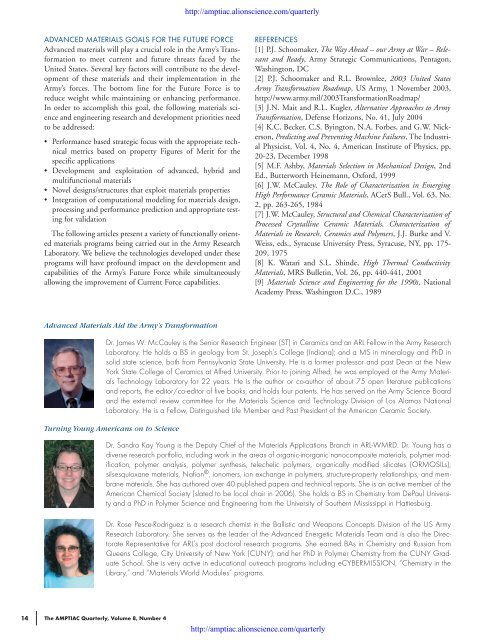Meeting New Challenges: Advanced Materials Aid the Army's ...
Meeting New Challenges: Advanced Materials Aid the Army's ...
Meeting New Challenges: Advanced Materials Aid the Army's ...
- No tags were found...
Create successful ePaper yourself
Turn your PDF publications into a flip-book with our unique Google optimized e-Paper software.
ADVANCED MATERIALS GOALS FOR THE FUTURE FORCE<strong>Advanced</strong> materials will play a crucial role in <strong>the</strong> Army’s Transformationto meet current and future threats faced by <strong>the</strong>United States. Several key factors will contribute to <strong>the</strong> developmentof <strong>the</strong>se materials and <strong>the</strong>ir implementation in <strong>the</strong>Army’s forces. The bottom line for <strong>the</strong> Future Force is toreduce weight while maintaining or enhancing performance.In order to accomplish this goal, <strong>the</strong> following materials scienceand engineering research and development priorities needto be addressed:• Performance based strategic focus with <strong>the</strong> appropriate technicalmetrics based on property Figures of Merit for <strong>the</strong>specific applications• Development and exploitation of advanced, hybrid andmultifunctional materials• Novel designs/structures that exploit materials properties• Integration of computational modeling for materials design,processing and performance prediction and appropriate testingfor validationThe following articles present a variety of functionally orientedmaterials programs being carried out in <strong>the</strong> Army ResearchLaboratory. We believe <strong>the</strong> technologies developed under <strong>the</strong>seprograms will have profound impact on <strong>the</strong> development andcapabilities of <strong>the</strong> Army’s Future Force while simultaneouslyallowing <strong>the</strong> improvement of Current Force capabilities.REFERENCES[1] P.J. Schoomaker, The Way Ahead – our Army at War – Relevantand Ready, Army Strategic Communications, Pentagon,Washington, DC[2] P.J. Schoomaker and R.L. Brownlee, 2003 United StatesArmy Transformation Roadmap, US Army, 1 November 2003,http://www.army.mil/2003TransformationRoadmap/[3] J.N. Mait and R.L. Kugler, Alternative Approaches to ArmyTransformation, Defense Horizons, No. 41, July 2004[4] K.C. Becker, C.S. Byington, N.A. Forbes, and G.W. Nickerson,Predicting and Preventing Machine Failures, The IndustrialPhysicist, Vol. 4, No. 4, American Institute of Physics, pp.20-23, December 1998[5] M.F. Ashby, <strong>Materials</strong> Selection in Mechanical Design, 2ndEd., Butterworth Heinemann, Oxford, 1999[6] J.W. McCauley, The Role of Characterization in EmergingHigh Performance Ceramic <strong>Materials</strong>, ACerS Bull., Vol. 63, No.2, pp. 263-265, 1984[7] J.W. McCauley, Structural and Chemical Characterization ofProcessed Crystalline Ceramic <strong>Materials</strong>, Characterization of<strong>Materials</strong> in Research, Ceramics and Polymers, J.J. Burke and V.Weiss, eds., Syracuse University Press, Syracuse, NY, pp. 175-209, 1975[8] K. Watari and S.L. Shinde, High Thermal Conductivity<strong>Materials</strong>, MRS Bulletin, Vol. 26, pp. 440-441, 2001[9] <strong>Materials</strong> Science and Engineering for <strong>the</strong> 1990s, NationalAcademy Press, Washington D.C., 1989<strong>Advanced</strong> <strong>Materials</strong> <strong>Aid</strong> <strong>the</strong> Army’s TransformationDr. James W. McCauley is <strong>the</strong> Senior Research Engineer (ST) in Ceramics and an ARL Fellow in <strong>the</strong> Army ResearchLaboratory. He holds a BS in geology from St. Joseph’s College (Indiana); and a MS in mineralogy and PhD insolid state science, both from Pennsylvania State University. He is a former professor and past Dean at <strong>the</strong> <strong>New</strong>York State College of Ceramics at Alfred University. Prior to joining Alfred, he was employed at <strong>the</strong> Army <strong>Materials</strong>Technology Laboratory for 22 years. He is <strong>the</strong> author or co-author of about 75 open literature publicationsand reports, <strong>the</strong> editor/co-editor of five books, and holds four patents. He has served on <strong>the</strong> Army Science Boardand <strong>the</strong> external review committee for <strong>the</strong> <strong>Materials</strong> Science and Technology Division of Los Alamos NationalLaboratory. He is a Fellow, Distinguished Life Member and Past President of <strong>the</strong> American Ceramic Society.Turning Young Americans on to ScienceDr. Sandra Kay Young is <strong>the</strong> Deputy Chief of <strong>the</strong> <strong>Materials</strong> Applications Branch in ARL-WMRD. Dr. Young has adiverse research portfolio, including work in <strong>the</strong> areas of organic-inorganic nanocomposite materials, polymer modification,polymer analysis, polymer syn<strong>the</strong>sis, telechelic polymers, organically modified silicates (ORMOSILs),silsesquioxane materials, Nafion ® , ionomers, ion exchange in polymers, structure-property relationships, and membranematerials. She has authored over 40 published papers and technical reports. She is an active member of <strong>the</strong>American Chemical Society (slated to be local chair in 2006). She holds a BS in Chemistry from DePaul Universityand a PhD in Polymer Science and Engineering from <strong>the</strong> University of Sou<strong>the</strong>rn Mississippi in Hattiesburg.Dr. Rose Pesce-Rodriguez is a research chemist in <strong>the</strong> Ballistic and Weapons Concepts Division of <strong>the</strong> US ArmyResearch Laboratory. She serves as <strong>the</strong> leader of <strong>the</strong> <strong>Advanced</strong> Energetic <strong>Materials</strong> Team and is also <strong>the</strong> DirectorateRepresentative for ARL’s post doctoral research programs. She earned BAs in Chemistry and Russian fromQueens College, City University of <strong>New</strong> York (CUNY); and her PhD in Polymer Chemistry from <strong>the</strong> CUNY GraduateSchool. She is very active in educational outreach programs including eCYBERMISSION, “Chemistry in <strong>the</strong>Library,” and “<strong>Materials</strong> World Modules” programs.14The AMPTIAC Quarterly, Volume 8, Number 4
















